|
1603
|
King James VI of Scotland became, additionally, King James I of
England. At this time ensigns (a flag flown at the
stern of a ship) were commonly flown by ships of war, but not by merchant
ships. Most merchant ships flew a flag
from a top or masthead.
|
|
1606
|
A Proclamation declaring what
Flags South and North Britains
shall bear at Sea.
"Whereas some difference has
arisen between our Subjects of South and North Britain, Travelling by Sea,
about the bearing of their flags, for the avoiding of all such contentions
hereafter, We have with the advice of our Council ordered That from henceforth
all our subjects of this Isle and Kingdom of Great Britain and the Members
thereof shall bear in their maintop the Red Cross, commonly called St
George's Cross, and the White Cross, commonly called St Andrew's Cross,
joined together, according to a form made by our Heralds and sent by Us to
our Admiral to be published to our said Subjects. And in their foretop Our Subjects of South
Britain shall wear the Red Cross only as they were wont,
and our Subjects of North Britain in their
Foretop the White Cross only as they were accustomed. Wherefore We will and
command all our Subjects to be conformable and obedient to this Our Order,
and that from henceforth they do not use to bear their flags in any other
Sort, as they will answer the contrary at their Peril."
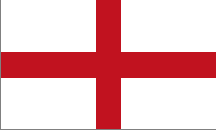
Saint George's Cross |
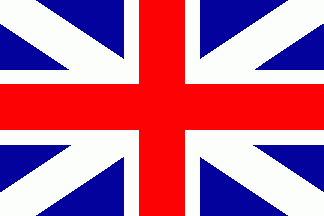
Union Flag |
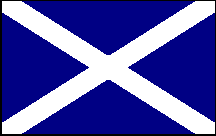
Saint Andrew's Cross |
"Given at our Palace
of Westminster the 12th day of April
in the 4th year of our Reign of Great Britain
France and Ireland
Annoq Domini 1606.
At first the new flag was called the "Britain" or "British" flag, a
name that persisted until at least 1639, but after 1625 it was also being
called the "Union". At this time,
in maritime parlance, "flag" did not have the very broad and
general meaning that it has to-day. It
was the specific name of a colour flown from a masthead or top, and the new
flag came to be called the Union Flag.
|
|
1625
|
By this time a
Union Flag at a masthead was being used on ships of war as the distinguishing
flag of an admiral.
|
|
1634
|
In 1634 use of the Union Flag was
restricted to ships in the service and pay of the King.
"A Proclamation appointing the
Flags, as well for our Navie Royall as for the
Ships of our Subjects of South and North Britaine."
"Wee taking into Our Royall
consideration that it is meete for the Honour of
Our owne Ships in Our Navie
Royall and of such other Ships as are or shall be employed in Our immediate
Service, that the same bee by their Flags distinguished from the ships of any
other of Our Subjects, doe hereby straitly prohibite and forbid that none of Our Subjects, of any of
Our Nations and Kingdomes, shall from hencefoorth presume to carry the Union Flagge in the Maine toppe, or
other part of any of their Ships (that is) S. Georges Crosse and S. Andrews
Crosse joyned together upon paine
of Our high displeasure, but that the same Union Flagge
bee still reserved as an ornament proper for Our owne
Ships and Ships in Our immediate Service and Pay, and none other.”

Saint George's Cross |

Union Flag |

Saint Andrew's Cross |
"And likewise Our further will
and pleasure is, that all the other Ships of Our Subjects of England or South
Britaine bearing flags shall from hencefoorth carry the Red‑Crosse, commonly called
S. George his Crosse, as of olde time hath beene used; And also that all the other ships of Our
Subjects of Scotland or North Britaine shall from hencefoorth carry the White Crosse commonly called S.
Andrews Crosse, Whereby the severall Shipping may
thereby bee distinguished and We thereby the better discerne
the number and goodnesse of the same. Wherefore Wee
will and straitly command all Our Subjects foorthwith to bee conformable and obedient to this Our
Order, as they will answer the contrary at their perills."
"Given at Our Court at Greenwich this fifth day of May in the tenth yeere of Our Reigne of England Scotland
France and Ireland,
Defender of the Faith &c."
At about the same time it
became usual for the King's ships to hoist a small version of the Union Flag
in their bows. The word 'jack' was
applied to things smaller than the normal size, and the small 'Union flag' in
the bow, became the 'Union jack-flag', which was shortened to 'Union
Jack'. Later the term was used even
when the flag was being put to other uses, and 'Union Jack',
or 'the King's Jack' became the usual name for the flag. During the latter part of the 19th century
it was argued that the flag should be called the Union Jack, only when it was
being used as a jack, and that at all other times it should be called the
Union Flag. This is a perfectly
reasonable argument, but the term 'Union Jack' had been used so widely and
for so long that it is generally considered that the terms 'Union Jack' and
'Union Flag' are completely interchangeable.
|
|
1649-1660
|
Variations of the
Union Jack used for different purposes during the inter regnum.
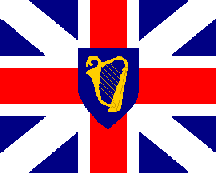
Lord Protector |
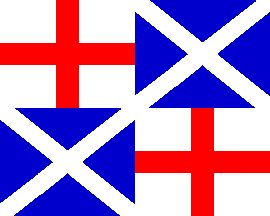
Naval Ensign |
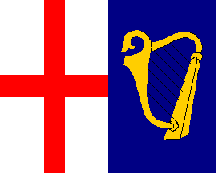
Commonwealth |
|
|
1660
|
Union Jack re-instated
|
|
1674
|
Use of flags similar in
appearance to the Union Jack resulted in the following proclamation.
"Whereas by ancient
usage no merchant's ship ought to bear the Jack, which is for distinction
appointed for his Majesty's ships; nevertheless his Majesty is informed that
divers of his Majesty's subjects have of late presumed to wear his Majesty's
Jack on board their ships employed in merchants' affairs, and thinking to
evade the Punishment due for the same, bear Jacks in shape and mixture of
colours so little different from those of his Majesty as not to be without
difficulty distinguisht therefrom,
which practice is found attended with manifold Inconveniences; for prevention
whereof for the future his Majesty hath thought fit, with the advice of his
Privy Council, by this his Royal Proclamation, strictly to charge and command
all his subjects whatsoever, that from henceforth they do not presume to wear
his Majesty's Jack (commonly called The Union jack) in any of their ships or
vessels, without particular warrant for their so doing from his Majesty, or
the Lord High Admiral of England, or the Commissioners for executing the
office of Lord High Admiral for the time being; and his Majesty doth hereby
further command all his loving subjects, that without such warrant as
aforesaid, they presume not to wear on board their ships or vessels, any
Jacks made in imitation of his Majesty's, or any other flags, Jacks, or
Ensigns whatsoever, than those usually heretofore worn on merchants' ships,
viz., the Flag and Jack White, with a Red Cross (commonly called Saint
George's Cross) passing right through the same; and the Ensign Red, with a
like Cross in a Canton White, at the upper corner thereof next to the staff,”

Saint George's Cross |

Merchant's Flag |
"And his Majesty
doth hereby require the principal officers and Commissioners of his navy,
Governors of his Forts and Castles, the Officers of his Customs and
Commanders or officers of any of his Majesty's ships, upon their meeting
with, or otherwise observing any merchants' ships or vessels of his Majesty's
subjects wearing such a flag, jack, or ensign, contrary hereunto, whether at
Sea or in Port, not only to cause such flag, jack or ensign to be forthwith
seized, but to return the names of the said ships and vessels, together with
the names of their respective masters, unto the Lord High Admiral, Lords Commissioners
of the Admiralty, or the judge of the High Court of Admiralty for the time
being, to the end the Persons offending may be duly punished for the same.”
"And his Majesty
doth hereby command and enjoyn the Judge and Judges
of the High Court of Admiralty for the time being, that at the several
Sessions to be hereafter held by his Majesty's Commission of Oyer and Terminer for the
Admiralty, they give in charge, that strict enquiry be made of all offences
in the premises, and that they cause all offenders therein to be duly
punished. And all Vice Admirals and
Judges of Vice Admiralties, are also to do the same, and to attend the due
observation hereof, within the several Ports and Places of their respective
Precincts.”
"Given at our Court
at Whitehall
the Eighteenth Day of September 1674, in the Six and Twentieth Year of our
Reign. By his Majesty's Command."
Reasons
why merchant ships and private yachts flew the Union Jack were noted by
Samuel Pepys, Secretary to the Admiralty, at the Navy Board on the 20th of
September 1686.
"Memorandum. That
the temptations to this Liberty
(besides the pride of it) are;
1st. That in Holland they are freed
by it from taking a Pilot.
2dly. As to France they
are by the Jack excused from paying the Duty of 50 Sous
by Tun paid by every Mercht
Man coming into a French Port.
3dly. All our
Merchant Men lower their Topsails below Gravesend to any ship or vessel
carrying the King's Jack, be it but a Victualling
Hoy."
|
|
1685
|
Earliest evidence that the
Union Jack was being flown from the King's castles and forts. A drawing of 1685 shows a Union Jack flying
from an Irish fort. A ship off the
coast has a plain ensign with a St
George's canton.
|
|
1694
|
The Union Jack
replaced the cross of St George in the canton of flags flown in ships
employed by government departments.
"Such Ships
and Vessels as shall be employed for Their Majesties' Service by the
Principal Officers and Commissioners of Their Majesties' Navy, the Principal
Officers of T.M. Ordnance, the Commissioners for Victualling T.M. Navy, the
Commissioners for T.M. Customs, and the
Commissioners for Transportation for T.M. Services,
relating particularly to those Offices shall wear a Red jack with the Union
Jack in a Canton at the upper corner thereof next the staff, as aforesaid,
and in the other part of the said Jack shall be described the Seal used in
the respective Offices aforesaid by which the said ships and vessels shall be
employed."
|
|
1701
|
A special Union Jack, defaced with a white escutcheon, was introduced for any ships commissioned by Governors of the North American Colonies by the Committee of the Whole Council.
"Whereas great
inconveniences do happen by Merchant Ships and other Vessels in the
Plantations wearing the Colours born by our Ships of War under pretence of
Commissions granted to them by the Governors of the said Plantations, and
that by trading under those Colours, not only amongst our own Subjects, but
also those of other Princes and States, and Committing divers
Irregularities, they do very much dishonour our Service --- For prevention
whereof you are to oblige the Commanders of all such Ships, to which you
shall grant Commissions, to wear no other
jack than according to the Sample here described, that is to say, such
as is worn by our Ships of War, with the distinction of a white Escutchion in the middle thereof and that the said mark
of distinction may extend itself to one half of the depth of the Jack and one
third of the Fly thereof."
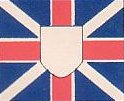
A Union Flag for
the North American Colonies
Although this special version of the Union Flag for use by the Royal Governors of the American Colonies was approved, it is unclear if this flag ever saw any actual use.
|
|
1707
|
The first article
of the Treaty of Union between England
and Scotland
provided that the crosses of St George and St Andrew should be conjoined as
the Queen thought fit. After the
consideration of various designs it was decided by Order in Council of 17
April "that the Union Flag should continue as at present". By a later Proclamation of 28 July the Union
Jack replaced the cross of St George in the canton of ensigns
|
|
18th
Century
|
During the course of the 18th
century fore and aft headsails replaced the square spritsails at the bow, and
the sprit topmast, on which the jack had been hoisted, was replaced by a
flagstaff on the bow sprit. This flagstaff
obstructed the jib when headsails were set and it became normal to fly a jack
only when in harbour. When steam
replaced sail this problem disappeared, but the tradition has persisted and
jacks are not flown when ships are under way, except on certain ceremonial
occasions.
|
|
1801
|
The Act of 1800 united
Great Britain and Ireland with effect 1 January 1801, and by the first of the
Articles of Union the Ensigns, Armorial Flags and Banners were to be such as
the king by Royal Proclamation under the Great Seal of the said United Kingdom
should appoint.
"Admiralty Office,
15 November 1800.
Gentlemen,
A Report from the Lords
of the Committee of the whole Council, dated 4th instant, having been read at
the Council Board on the Day following, in the Presence of the King's Most
Excellent Majesty, wherein the Lords of the Council declared as their opinion,
if His Majesty should so think fit, that His Royal proclamation to be issued
on the First Day of January next under the Great Seal of the United Kingdom,
appoint and declare that [details of the King's Royal Style and Title]
"That the Committee
were further of opinion that the Union Flag should be altered according to
the Draught thereof marked (C) in which the Cross of St George is conjoined
with the Crosses of St Andrew and St Patrick:
"And that the
Standard be the Arms of the United
Kingdom according to the Draught marked
(B);
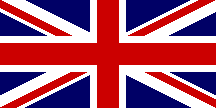
Union Jack/Flag |
"And that on and
after the First Day of January next ensuing the said Flags and Banners should
be hoisted and displayed on all His Majesty's Forts and Castles within the
United Kingdom, and the Islands of Guernsey, Jersey, Alderney, Sark, and Man,
and also on board all His Majesty's Ships of War, then lying in any of the
Ports or Harbours of the said United Kingdom, or of the Islands aforesaid,
and on board His Majesty's Ships employed on Foreign Service, as soon after
the said First Day of January next as His Majesty's Proclamation or Order in
Council shall be received by the Commanders of His Majesty's Ships employed
on Foreign Service; We herewith transmit to you a Printed Copy of His
Majesty's Order in Council of the 5th instant approving the Report of the
Lords of the Committee afore-mentioned, and do hereby desire and direct you
to cause such Flags and Standards as may be necessary to be prepared
conformably to the said Draughts for the use of His Majesty's Ships of War at
Home and on Foreign Stations, and to be supplied with them accordingly, with
all the dispatch that may be.”{
“You are also to cause
the Colours decribed in the said Order in Council
to be hoisted in all the Dock Yards of the Kingdom upon the 1st Day of
January next, and to supply the necessary Colours for the use of the Naval
Hospitals at Home, and the Naval Yards and Hospitals abroad, in the manner
directed by the said Order in Council;
We are Your
affectionate Friends,
Arden, J.Gambier, W.Young. Navy Board."
|
|
1821
|
The Lord-Lieutenant of Ireland flew a plain Union Jack from his
ship's masthead when crossing the Irish Sea. The Admiralty objected to this as the Union
Jack flown in this position was the distinguishing flag of an Admiral of the
Fleet. A special Union Jack defaced in
the centre by a gold harp on a blue shield was introduced for the
Lord-Lieutenant.
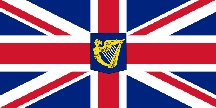
Lord-Lieutenant of Ireland
|
|
1869
|
Defaced Union Jacks for
use at sea were introduced for government officials whose flag ashore was the
Union Jack.
"The Union Jack having
been established by your Majesty's Regulations for the Naval Service as the
Distinguishing Flag to be borne by the Admiral of the Fleet, and whereas
great inconvenience has at times been experienced by the Union Jack having been
carried in boats and other vessels by Governors of Colonies, Military
Authorities, Diplomatic Officers and Consular Agents when embarked ...." The solution was the creation of Union
Jacks with different badges in the centre of the flag for specified
officials. In total, over the years,
there have been 145 different defaced Union Jacks, of which 23 are still in
use.
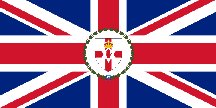
Governor of
Northern Ireland |
|
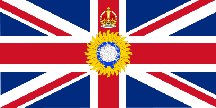
Lord-Viceroy
of India
|
|
|
1873
|
The earliest official reference
to the Union Jack as the national flag is in Queen's Army Regulations
1873. Section 3. Honours and
Salutes.
"The following is a list
of stations at which the national flag (Union Jack) is authorised to be
hoisted on anniversaries only, or when specially
required for saluting purposes."
|
|
1902
|
The Times newspaper
editorial of 18 September referred to a letter from Vicar of St Michael's
Church, Folkstone published in the 7 June
edition. The Vicar had spent £10
buying a Royal Standard thinking that he would be able to fly it from the
church tower as usual. When he asked
Lord Knollys, Edward VII's
private secretary, if an exception might be made, he was told that "the
Royal Standard can only be hoisted at the Coronation. You can always fly the Union Jack."

Royal Standard |

Union Jack |

Red Ensign |
After noting that some
people thought that the Red Ensign was the national flag, the editorial
pointed out that the Union Jack was a common feature, the only common
feature, of all ensigns whether Red, White or Blue, worn by British ships at
sea. Display of the Union Jack was the
international mark of all three, and the colour of the fly was in effect only
a municipal distinction.
October 4, 1902. Extract from Memorandum written by
Major-General Sir Arthur Ellis, Lord Chamberlain's Department.
"The case of the
Union Jack is different. This flag,
properly called the Union Flag was fixed by Order in Council in 1800, the
year of the Union of the crowns of England
and Ireland. This Order was made in pursuance of the Act
of Union (1800), which enables the King by Order in Council, to appoint the
ensigns armorial flags and banners of the United Kingdom. The flag was formed by a union of the sea
flags of England, Ireland and Scotland. The Order in Council however does not say
when and by whom the Union Flag is to be used, nor is the use thereof in any
way regulated. At sea, as has been
said, the use of the Union Flag has been regulated by Admiralty orders, but
on land there has been no prohibition of its use, and it has always been
treated by general consent as the national flag and used indicriminately
everywhere."
|
|
1908
|
In answer to a question in the House
of Lords on 14th July, the Earl of Crewe replied that "the Union Jack should be regarded as the national flag, and it
undoubtedly may be flown on land by all His Majesty’s subjects”
|
|
1933
|
In reply to a
parliamentary question on Tuesday 27 June as to whether private citizens were
prevented from flying the Union Flag, the Home Secretary (Sir J Gilmour)
said
"No Sir, the Union Flag is the
national flag and may properly be flown by any British subject on land"
|
|
1941
|
In colonies the Union Jack was
flown on Government House from sunrise to sunset when the governor was in
residence. This lead to a widespread but incorrect belief that the Union Jack
was the Governor's personal flag, and could not be flown by anyone else. "In certain territories the Union
Flag is seldom if ever flown by members of the general public. The Union Flag is perceived as the
Governors' flag, as they rarely embark and use the defaced Union Flag."
The regulations were changed. The defaced Union Jack became a Governor's
flag on land so that general use of the plain Union Jack could be
encouraged. "Otherwise bases in
the West Indies leased to the United States
(in exchange for forty destroyers) would be a sea of Stars and Stripes
with no Union Jacks in sight."
|
|